WORLD CLASS COACHING
Soccer Drills and Small-Sided Games

TABLE OF CONTENTS
Part One
- Switching the Point of Attack
- Attacking Transition With Numbers Up
- 3 v 3 Small-Sided Game to Goal
- How To Find "The Hole" to Pass In To
- A 5v4 Defending Small-Sided Game
Part Two
- Pass and Move in Three’s
- Midfield/Forward Combination Play
- 3 v 1 Possession Small-Sided Game
- A Passing and Overlap Exercise
- Possession to Penetrate
Part Three
- The Attacking Fourth of the Field
- How to Improve Decision Making
- Attacking Combinations
- Staying Compact Defensively
- Long Passes
- A Killer Overlap Drill
Switching the Point of Attack
By Eric Clermont -
When developing a possession based style at the youth level (as I have done over the last few years), I believe that the focus on always needing to play short becomes predominant for many teams. While there are clear pros to this, players are often given only the technical tools to play this way and no tactical context in order for them to be successful. We are not talking here about the wins and losses column, but specifically about their ability to keep possession when ‘trapped’ on one side of the field and the understanding of when to ‘open up’ the play and switch the point of attack. In the modern professional game, the ability to play out of tight pockets into areas of space is a must. Teaching players early with the simple but effective practices below will put them on the right path.
Warm Up
Organization
Players pass around with one ball in group of 4. 2 play in the middle with 2 on the outside. Keep switching roles. Work through combining through the 2 central midfielders in the middle to switch to the other side. 2 sets of players work in one box (one team going horizontally and the other going vertically), but are unopposed to add some difficulty. Coach can teach certain patterns for players to practice.
Progression
Players can switch positions with outside players after playing the ball outside. Active Recovery- Coaching points while players do dynamic stretches.
Coaching Points
- Technical decisions of passing/dribbling and combining
- Speed of play and body shape when switching point of attack
- Angles and distances of support for the player with the ball
- Ensure players are never in a straight line (always at an angle to the player with the ball)
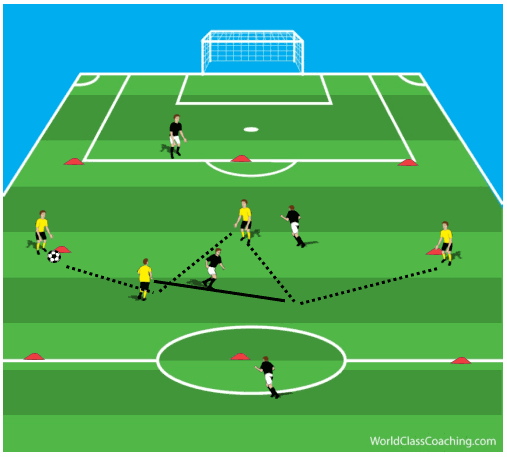
Small Sided Game
Organization
Opposed exercise on switching the point of attack. Players split up into fours (3 teams if possible, but defensive team can have less). Field split into two 15 x 15 yard grids at each end and a 5 x 15 yard narrow channel in the middle for the defensive team. A team must play five passes and then switch to the other side for a point. Team in the middle must send 2 defenders for a 4 v 2. When they win the ball, they win a point. Continue for 3 minutes and then switch the team in the middle.
Coaching Points
- Technical aspects of short and long passing
- Combinations to create space
- Movement and creating angles/distances for player to switch the ball to other side
- Decision making of whether to play short/long
- Team on opposite side get into attacking shape early in order to keep possession when ball is switched
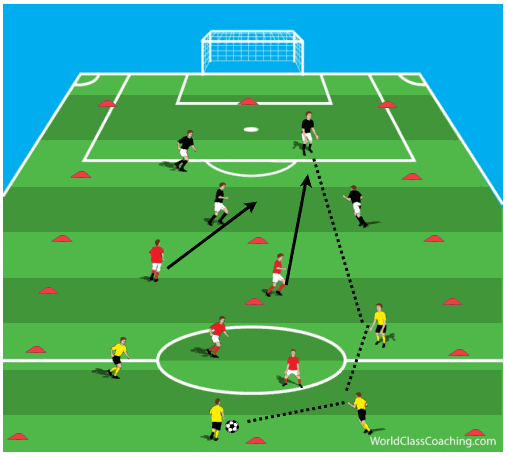
Extended Activity
Organization
Three central midfielders work to work together to change the point of attack by using the outside backs/ wingers on the side and the centre back and striker on either side. Server plays a ball into the box where the 3 midfielders and CB and ST work to establish a rhythm and tempo in a 7 vs. 3. Players on outside play 2 touch and must play inside, forcing 3 midfielders to create passing lanes. Switch the point at least once, play a two player combination and play in to opposite target to score. If red team win possession, they reload through one of the targets and attack towards the other side.
Coaching Points
- Change the rhythm and tempo of the play with short and long passes
- Decision whether to penetrate 1 v 1 or to combine with neutral player
- Outplaying your direct opponent. Body shape to receive (open)
- Vision and awareness to see both short and long options
- Rotation and shape of the midfield triangle in support of the wide and deep players to create space and passing lines
- Speed of play when attacking- less touches and more penetrating passes
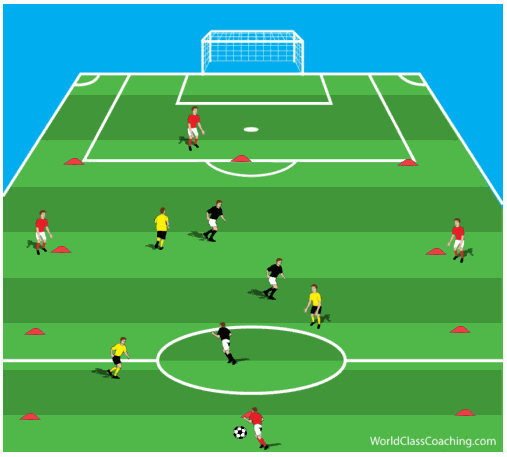
Attacking Transition With Numbers Up
Today’s featured activity works on numbers up attacking, numbers down defending and offensive transition.
Start with a 40 x 30 grid with two full sized goals and a keeper in each goal.

Two attacking players and one defending player starts on the field and additional players from each team start on the side.

Using this example the black team attacks the top goal and when they lose possession (by scoring, by shooting and it going over the goal or wide, or by the other player or keeper winning the ball) the two attacking players leave the field and are replaced by one defending player and a second attacking player adds on and the attack goes in the other direction

This becomes a very fast moving, free flowing game of soccer and the quicker the transitions from defense to offense the more effective the attacks.
You can do this same thing with 3 v 2, 4 v 3 or even 5 v 4. The key is to emphasize the fast transition and the importance of getting to goal quickly.
3v3 Small-Sided Game to Goal
This activity is a 3 v 3 game to one goal.
Start with a 40 x 30 grid with a goal in the middle made up on cones or flags. A keeper is in the goal and a server is off the field with some balls. There are 3 players for each team
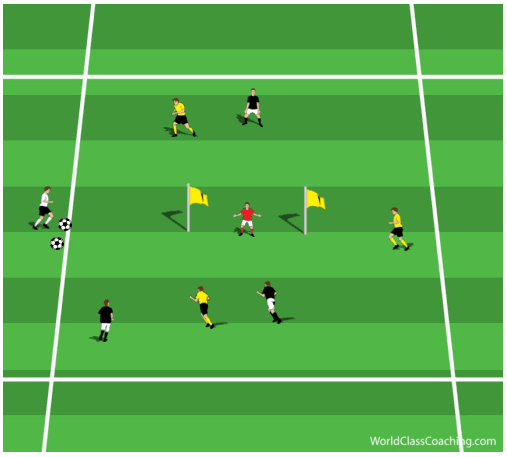
Each team is assigned an attacking side of field and that is the side they must score from

This is a regular game of 3 v 3 except for the field configuration. Any player can go on any side of the field at any time BUT only the keeper may run through the goal.
If the ball goes out of play, the server players a new ball into the team who it didn’t go off of.

If a goal is scored the server plays the ball to the other team.

If the keeper makes the save, he plays the ball to the other team

This is a very fast moving game that will require the players to think, communicate and move a lot in order to maintain some type of shape and balance on offense and defense.
How To Find "The Hole" to Pass In To
This activity works on midfielders finding holes to pass into.
This activity uses half a field and has a full sized goal with a keeper in it. There are 3 midfielders on attack and 3 midfielders defending. They are restricted to an area from the midfield line to another line 25 yards closer to goal. There is one attacking forward between the top of the 18 and the midfielders restricting line
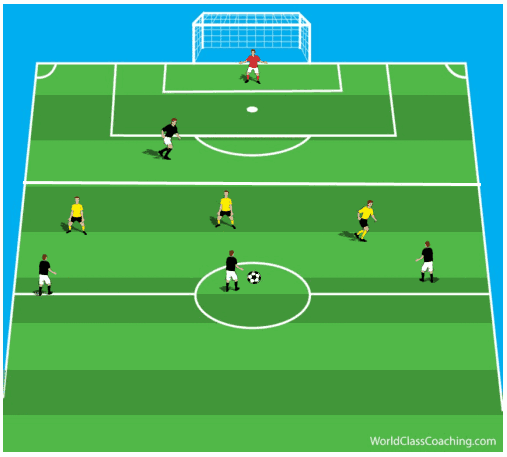
The attacking midfielders pass the ball between them while looking to find a hole to pass through to find the forward


The forward receives the ball and tries to hit a quick shot on goal.

The defending midfielders try to shift to make it more difficult for the attackers to find the holes
Once the players get comfortable with this, next add a second forward and also a defender in back

Now the attacking players have to play quicker since the defenders can put more pressure on the forwards.
Once this has been done for awhile, add a second defender in back

Next, add a third defender in back and remove the constraining line to allow for a 5 v 6 attack on goal.

This type of a progression will allow the players to understand the concept of looking for holes and trying to make penetrating passes to the forwards.
A 5v4 Defending Small-Sided Game
This small-sided game works on 5 v 4 defending.
We are using a 40 x 30 grid with a small goal on each end line. There are two teams of 4’s on the field and an extra player behind each goal.
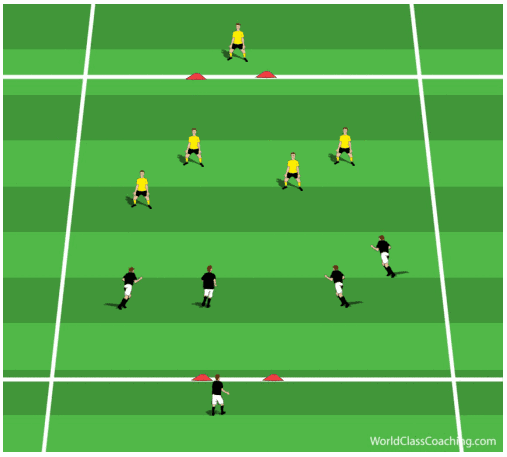
Whichever team has the ball their extra player join in. So if yellow starts with the ball, the yellow add on joins in and it’s 5 yellows vs 4 blacks

The defending team must adjust based on who has the ball, where players are on the field etc.
As a general rule of thumb, the most dangerous player on the field is the one with the ball so he must always be contained/delayed/pressured. Next is the player closest to goal and then each other player based on distance to goal.

When the black team loses the ball the yellow add on player leaves the field and the black add on player joins in

There are two ways to do the add on players. If it’s a 10 minute game each player would be the add on player for a two minute period. The other way, which requires more thinking and communication, is to assign each player a number and the first time they defend, player 1 is the add on. When they defend the second time, player 2 is the add on and they keep rotating from there.
This is an excellent way to get players to work on defending with shape and balance and communicating throughout.




